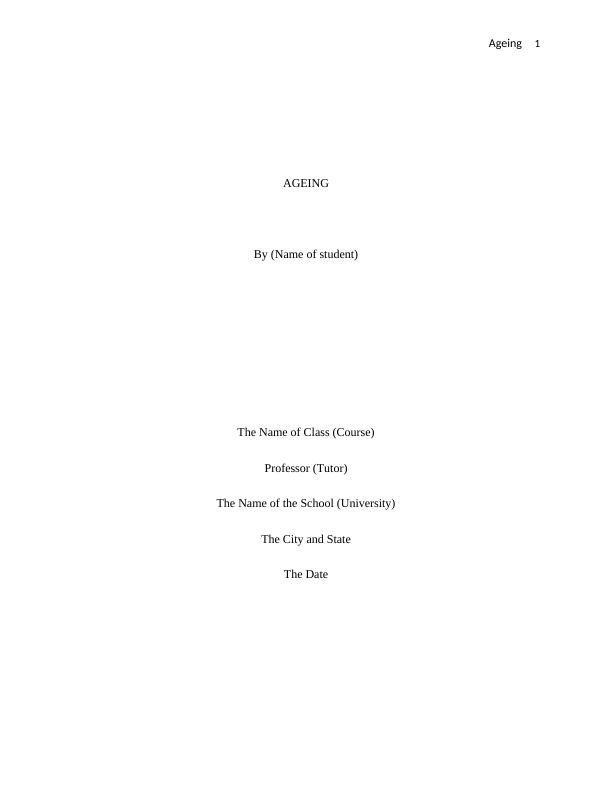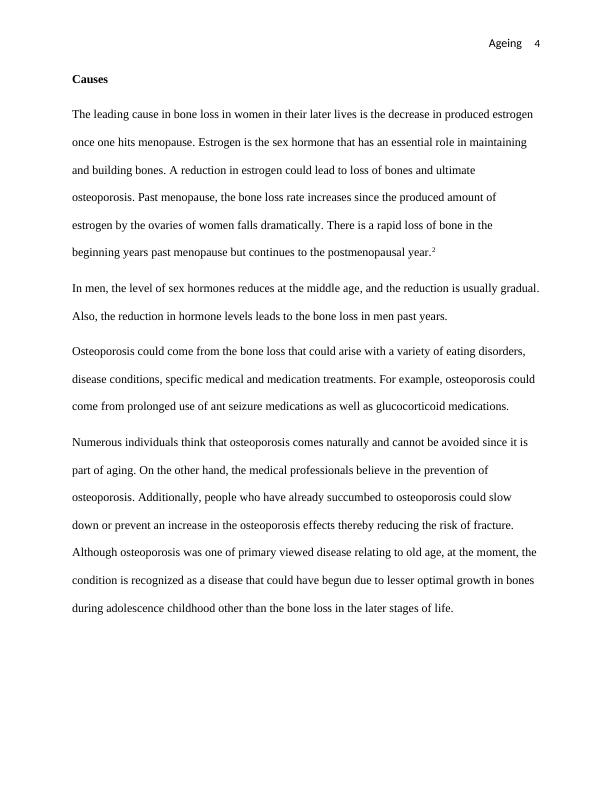Prevention and Impacts of Osteoporosis in Ageing Population
Added on 2023-06-03
20 Pages5384 Words111 Views
Ageing 1
AGEING
By (Name of student)
The Name of Class (Course)
Professor (Tutor)
The Name of the School (University)
The City and State
The Date
AGEING
By (Name of student)
The Name of Class (Course)
Professor (Tutor)
The Name of the School (University)
The City and State
The Date

Ageing 2
Executive Summary
This paper first begins with the definition of osteoporosis which is low bone strength condition
causing high risks of broken legs or fracture before looking into more fact on osteoporosis such
as how common it is, its causes and who is most affected by osteoporosis? As well as its impacts.
Osteoporosis has had its fair share of terrorizing the aged, but some prevention measures have
been discovered to control the condition. Preventive measures such as population-intervention
strategies on the importance of physical exercises among others are discussed in this paper
before getting into one research done on the prevention of osteoporosis. The research is from the
National Bone Health Campaign, and it studies proper ways of preventing osteoporosis by
educating the public on early prevention measures such as alerting the young population.
Executive Summary
This paper first begins with the definition of osteoporosis which is low bone strength condition
causing high risks of broken legs or fracture before looking into more fact on osteoporosis such
as how common it is, its causes and who is most affected by osteoporosis? As well as its impacts.
Osteoporosis has had its fair share of terrorizing the aged, but some prevention measures have
been discovered to control the condition. Preventive measures such as population-intervention
strategies on the importance of physical exercises among others are discussed in this paper
before getting into one research done on the prevention of osteoporosis. The research is from the
National Bone Health Campaign, and it studies proper ways of preventing osteoporosis by
educating the public on early prevention measures such as alerting the young population.

Ageing 3
Introduction
Defining Osteoporosis
Osteoporosis is an illness characterized by low bone strength causing high risks of broken legs or
fracture. Bone strength consists of two elements: bone quality and amount of bone (bone mass).
Osteoporosis is the main underlying factor leading to fractures in women at postmenopausal and
the aged. Fracture more often happen in hip bones, wrist and spine although any bone could be
affected. Fractures especially occurring in the hip bone may disable permanently.1 Hence, there
is the need for studying and looking for preventive measures to the condition that affects the
ageing.
Body
How common it is
After 35 years of age, the difference in the bone mass which is removed and the laid down bone
mass begins to get imbalanced due to the process of aging slightly. Hence, there is a beginning in
the reduction of the overall quantity of bone mass. This condition is widely known as ‘bone
thinning' ‘bone loss.' However, this doesn't mean that the bones would look different from the
outside, but the inside has the cortical thins and as well as the struts that make up the bone's inner
structure reduce in its thickness or sometimes breaking down. Therefore, there is a result being
holes identical to honeycomb structures. The structure becomes larger thus leading to
osteoporosis that means porous bones. The quality change in bones is significantly likely to
increase its rate as one grows older thereby explaining the reason for bones increasing their
fragility and a higher percentage of fractures.
Introduction
Defining Osteoporosis
Osteoporosis is an illness characterized by low bone strength causing high risks of broken legs or
fracture. Bone strength consists of two elements: bone quality and amount of bone (bone mass).
Osteoporosis is the main underlying factor leading to fractures in women at postmenopausal and
the aged. Fracture more often happen in hip bones, wrist and spine although any bone could be
affected. Fractures especially occurring in the hip bone may disable permanently.1 Hence, there
is the need for studying and looking for preventive measures to the condition that affects the
ageing.
Body
How common it is
After 35 years of age, the difference in the bone mass which is removed and the laid down bone
mass begins to get imbalanced due to the process of aging slightly. Hence, there is a beginning in
the reduction of the overall quantity of bone mass. This condition is widely known as ‘bone
thinning' ‘bone loss.' However, this doesn't mean that the bones would look different from the
outside, but the inside has the cortical thins and as well as the struts that make up the bone's inner
structure reduce in its thickness or sometimes breaking down. Therefore, there is a result being
holes identical to honeycomb structures. The structure becomes larger thus leading to
osteoporosis that means porous bones. The quality change in bones is significantly likely to
increase its rate as one grows older thereby explaining the reason for bones increasing their
fragility and a higher percentage of fractures.

Ageing 4
Causes
The leading cause in bone loss in women in their later lives is the decrease in produced estrogen
once one hits menopause. Estrogen is the sex hormone that has an essential role in maintaining
and building bones. A reduction in estrogen could lead to loss of bones and ultimate
osteoporosis. Past menopause, the bone loss rate increases since the produced amount of
estrogen by the ovaries of women falls dramatically. There is a rapid loss of bone in the
beginning years past menopause but continues to the postmenopausal year.2
In men, the level of sex hormones reduces at the middle age, and the reduction is usually gradual.
Also, the reduction in hormone levels leads to the bone loss in men past years.
Osteoporosis could come from the bone loss that could arise with a variety of eating disorders,
disease conditions, specific medical and medication treatments. For example, osteoporosis could
come from prolonged use of ant seizure medications as well as glucocorticoid medications.
Numerous individuals think that osteoporosis comes naturally and cannot be avoided since it is
part of aging. On the other hand, the medical professionals believe in the prevention of
osteoporosis. Additionally, people who have already succumbed to osteoporosis could slow
down or prevent an increase in the osteoporosis effects thereby reducing the risk of fracture.
Although osteoporosis was one of primary viewed disease relating to old age, at the moment, the
condition is recognized as a disease that could have begun due to lesser optimal growth in bones
during adolescence childhood other than the bone loss in the later stages of life.
Causes
The leading cause in bone loss in women in their later lives is the decrease in produced estrogen
once one hits menopause. Estrogen is the sex hormone that has an essential role in maintaining
and building bones. A reduction in estrogen could lead to loss of bones and ultimate
osteoporosis. Past menopause, the bone loss rate increases since the produced amount of
estrogen by the ovaries of women falls dramatically. There is a rapid loss of bone in the
beginning years past menopause but continues to the postmenopausal year.2
In men, the level of sex hormones reduces at the middle age, and the reduction is usually gradual.
Also, the reduction in hormone levels leads to the bone loss in men past years.
Osteoporosis could come from the bone loss that could arise with a variety of eating disorders,
disease conditions, specific medical and medication treatments. For example, osteoporosis could
come from prolonged use of ant seizure medications as well as glucocorticoid medications.
Numerous individuals think that osteoporosis comes naturally and cannot be avoided since it is
part of aging. On the other hand, the medical professionals believe in the prevention of
osteoporosis. Additionally, people who have already succumbed to osteoporosis could slow
down or prevent an increase in the osteoporosis effects thereby reducing the risk of fracture.
Although osteoporosis was one of primary viewed disease relating to old age, at the moment, the
condition is recognized as a disease that could have begun due to lesser optimal growth in bones
during adolescence childhood other than the bone loss in the later stages of life.

End of preview
Want to access all the pages? Upload your documents or become a member.
Related Documents
Nursing Interventions of Women with Osteoporosislg...
|36
|5697
|87
Osteoporosis: Prevalence, Risk Factors, and Preventionlg...
|9
|1688
|420
Evaluation of Osteoporosis Awareness Among Post-Menopausal Womenlg...
|21
|5076
|422
NUR3005: Chronic Illness Management | Assignmentlg...
|16
|4572
|175
Epidemiology of Non-Communicable Diseaseslg...
|7
|1494
|108
Risks and Management of Osteoporosis in Women: A Case Studylg...
|17
|3782
|171
